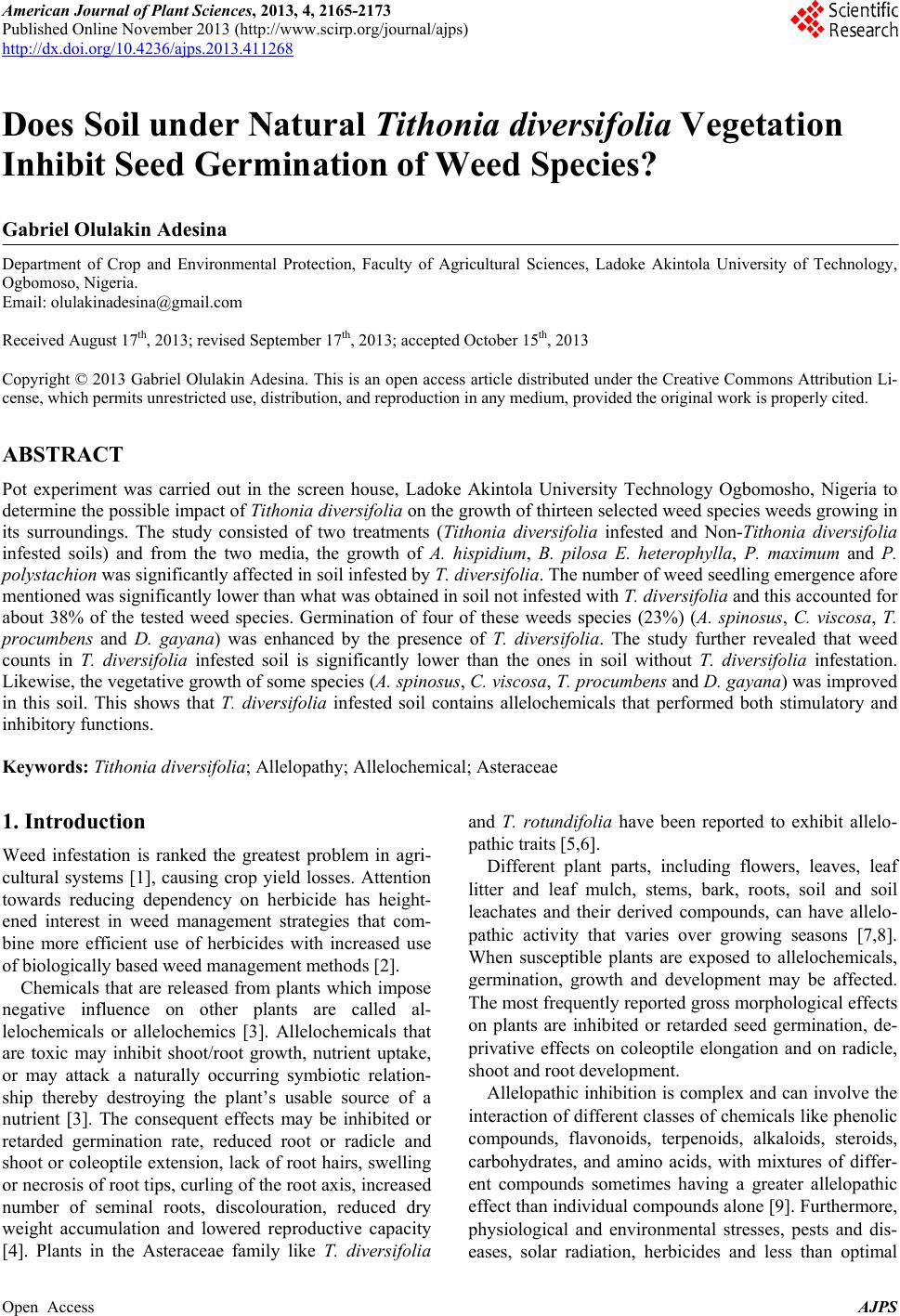 American Journal of Plant Sciences, 2013, 4, 2165-2173 Published Online November 2013 (http://www.scirp.org/journal/ajps) http://dx.doi.org/10.4236/ajps.2013.411268 Open Access AJPS 2165 Does Soil under Natural Tithonia diversifolia Vegetation Inhibit Seed Germination of Weed Species? Gabriel Olulakin Adesina Department of Crop and Environmental Protection, Faculty of Agricultural Sciences, Ladoke Akintola University of Technology, Ogbomoso, Nigeria. Email: olulakinadesina@gmail.com Received August 17th, 2013; revised September 17th, 2013; accepted October 15th, 2013 Copyright © 2013 Gabriel Olulakin Adesina. This is an open access article distributed under the Creative Commons Attribution Li- cense, which permits unrestricted use, distribution, and reproduction in any medium, provided the original work is properly cited. ABSTRACT Pot experiment was carried out in the screen house, Ladoke Akintola University Technology Ogbomosho, Nigeria to determine the possible impact of Tithonia diversifolia on the growth of thirteen selected weed species weeds growing in its surroundings. The study consisted of two treatments (Tithonia diversifolia infested and Non-Tithonia diversifolia infested soils) and from the two media, the growth of A. hispidium, B. pilosa E. heterophylla, P. maximum and P. polystachion was significantly affected in soil infested by T. diversifolia. The number of weed seedling emergence afore mentioned was significantly lower than what was obtained in soil not infested with T. diversifolia and this accounted for about 38% of the tested weed species. Germination of four of these weeds species (23%) (A. spinosus, C. viscosa, T. procumbens and D. gayana) was enhanced by the presence of T. diversifolia. The study further revealed that weed counts in T. diversifolia infested soil is significantly lower than the ones in soil without T. diversifolia infestation. Likewise, the vegetative growth of some species (A. spinosu s, C. viscosa, T. procumbens and D. gayana) was improved in this soil. This shows that T. diversifolia infested soil contains allelochemicals that performed both stimulatory and inhibitory functions. Keywords: Tithonia diversifolia; Allelopathy; Allelochemical; Asteraceae 1. Introduction Weed infestation is ranked the greatest problem in agri- cultural systems [1], causing crop yield losses. Attention towards reducing dependency on herbicide has height- ened interest in weed management strategies that com- bine more efficient use of herbicides with increased use of biologically based weed management methods [2]. Chemicals that are released from plants which impose negative influence on other plants are called al- lelochemicals or allelochemics [3]. Allelochemicals that are toxic may inhibit shoot/root growth, nutrient uptake, or may attack a naturally occurring symbiotic relation- ship thereby destroying the plant’s usable source of a nutrient [3]. The consequent effects may be inhibited or retarded germination rate, reduced root or radicle and shoot or coleoptile extension, lack of root hairs, swelling or necrosis of root tips, curling of the root axis, increased number of seminal roots, discolouration, reduced dry weight accumulation and lowered reproductive capacity [4]. Plants in the Asteraceae family like T. diversifolia and T. rotundifolia have been reported to exhibit allelo- pathic traits [5,6]. Different plant parts, including flowers, leaves, leaf litter and leaf mulch, stems, bark, roots, soil and soil leachates and their derived compounds, can have allelo- pathic activity that varies over growing seasons [7,8]. When susceptible plants are exposed to allelochemicals, germination, growth and development may be affected. The most frequently reported gross morphological effects on plants are inhibited or retarded seed germination, de- privative effects on coleoptile elongation and on radicle, shoot and root development. Allelopathic inhibition is complex and can involve the interaction of different classes of chemicals like phenolic compounds, flavonoids, terpenoids, alkaloids, steroids, carbohydrates, and amino acids, with mixtures of differ- ent compounds sometimes having a greater allelopathic effect than individual compounds alone [9]. Furthermore, physiological and environmental stresses, pests and dis- eases, solar radiation, herbicides and less than optimal 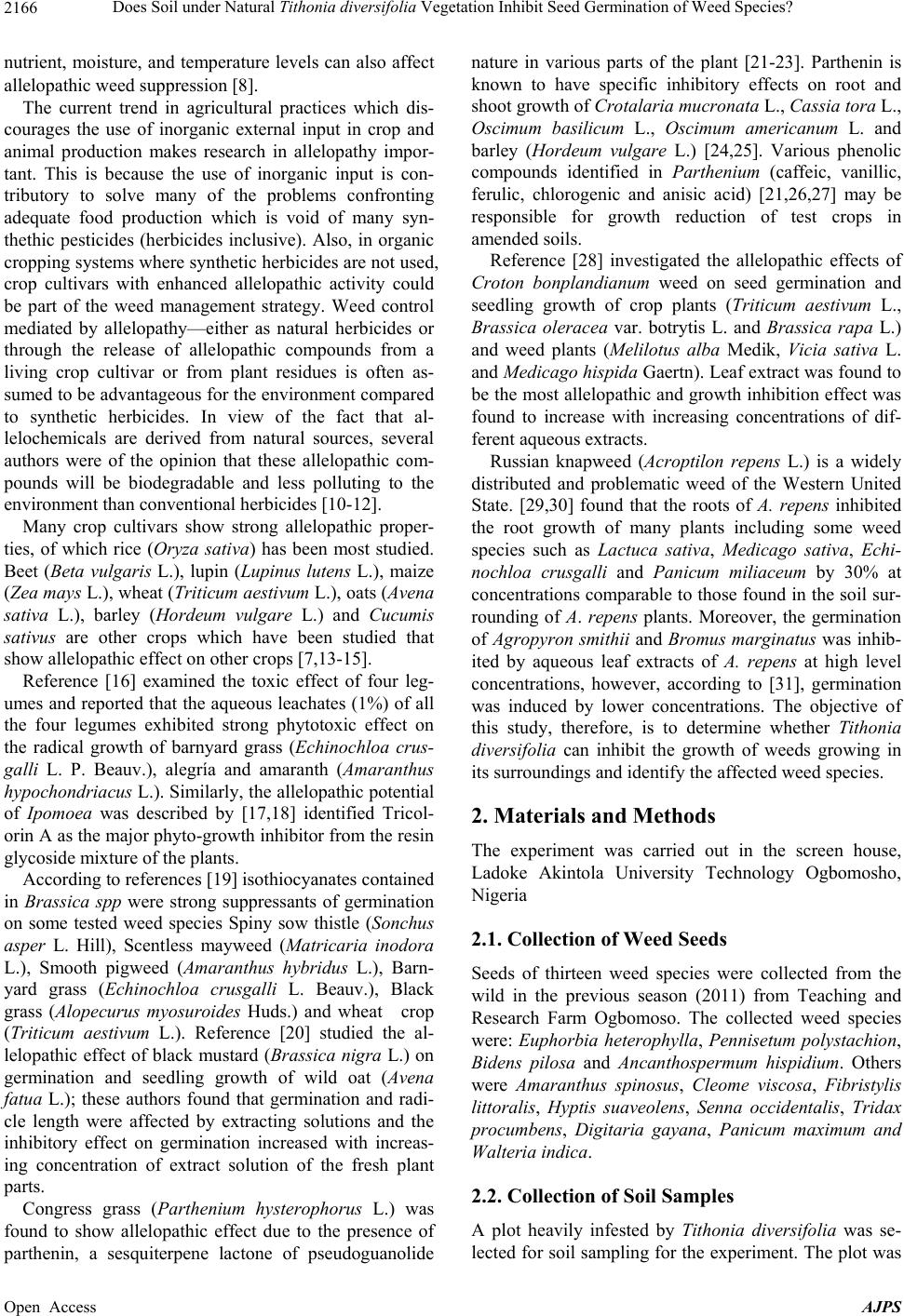 Does Soil under Natural Tithonia diversifolia Vegetation Inhibit Seed Germination of Weed Species? 2166 nutrient, moisture, and temperature levels can also affect allelopathic weed suppression [8]. The current trend in agricultural practices which dis- courages the use of inorganic external input in crop and animal production makes research in allelopathy impor- tant. This is because the use of inorganic input is con- tributory to solve many of the problems confronting adequate food production which is void of many syn- thethic pesticides (herbicides inclusive). Also, in organic cropping systems where synthetic herbicides are not used, crop cultivars with enhanced allelopathic activity could be part of the weed management strategy. Weed control mediated by allelopathy—either as natural herbicides or through the release of allelopathic compounds from a living crop cultivar or from plant residues is often as- sumed to be advantageous for the environment compared to synthetic herbicides. In view of the fact that al- lelochemicals are derived from natural sources, several authors were of the opinion that these allelopathic com- pounds will be biodegradable and less polluting to the environment than conventional herbicides [10-12]. Many crop cultivars show strong allelopathic proper- ties, of which rice (Oryza sativa) has been most studied. Beet (Beta vulgaris L.), lupin (Lupinus lutens L.), maize (Zea mays L.), wheat (Triticum aestivum L.), oats (Avena sativa L.), barley (Hordeum vulgare L.) and Cucumis sativus are other crops which have been studied that show allelopathic effect on other crops [7,13-15]. Reference [16] examined the toxic effect of four leg- umes and reported that the aqueous leachates (1%) of all the four legumes exhibited strong phytotoxic effect on the radical growth of barnyard grass (Echinochloa crus- galli L. P. Beauv.), alegría and amaranth (Amaranthus hypochondriacus L.). Similarly, the allelopathic potential of Ipomoea was described by [17,18] identified Tricol- orin A as the major phyto-growth inhibitor from the resin glycoside mixture of the plants. According to references [19] isothiocyanates contained in Brassica spp were strong suppressants of germination on some tested weed species Spiny sow thistle (Sonchus asper L. Hill), Scentless mayweed (Matricaria inodora L.), Smooth pigweed (Amaranthus hybridus L.), Barn- yard grass (Echinochloa crusgalli L. Beauv.), Black grass (Alopecurus myosuroides Huds.) and wheat crop (Triticum aestivum L.). Reference [20] studied the al- lelopathic effect of black mustard (Brassica nigra L.) on germination and seedling growth of wild oat (Avena fatua L.); these authors found that germination and radi- cle length were affected by extracting solutions and the inhibitory effect on germination increased with increas- ing concentration of extract solution of the fresh plant parts. Congress grass (Parthenium hysterophorus L.) was found to show allelopathic effect due to the presence of parthenin, a sesquiterpene lactone of pseudoguanolide nature in various parts of the plant [21-23]. Parthenin is known to have specific inhibitory effects on root and shoot growth of Crotalaria mucronata L., Cassia tora L., Oscimum basilicum L., Oscimum americanum L. and barley (Hordeum vulgare L.) [24,25]. Various phenolic compounds identified in Parthenium (caffeic, vanillic, ferulic, chlorogenic and anisic acid) [21,26,27] may be responsible for growth reduction of test crops in amended soils. Reference [28] investigated the allelopathic effects of Croton bonplandianum weed on seed germination and seedling growth of crop plants (Triticum aestivum L., Brassica oleracea var. botrytis L. and Brassica rapa L.) and weed plants (Melilotus alba Medik, Vicia sativa L. and Medicago hispida Gaertn). Leaf extract was found to be the most allelopathic and growth inhibition effect was found to increase with increasing concentrations of dif- ferent aqueous extracts. Russian knapweed (Acroptilon repens L.) is a widely distributed and problematic weed of the Western United State. [29,30] found that the roots of A. repens inhibited the root growth of many plants including some weed species such as Lactuca sativa, Medicago sativa, Echi- nochloa crusgalli and Panicum miliaceum by 30% at concentrations comparable to those found in the soil sur- rounding of A. repens plants. Moreover, the germination of Agropyron smithii and Bromus marginatus was inhib- ited by aqueous leaf extracts of A. repens at high level concentrations, however, according to [31], germination was induced by lower concentrations. The objective of this study, therefore, is to determine whether Tithonia diversifolia can inhibit the growth of weeds growing in its surroundings and identify the affected weed species. 2. Materials and Methods The experiment was carried out in the screen house, Ladoke Akintola University Technology Ogbomosho, Nigeria 2.1. Collection of Weed Seeds Seeds of thirteen weed species were collected from the wild in the previous season (2011) from Teaching and Research Farm Ogbomoso. The collected weed species were: Euphorbia heterophylla, Pennisetum polystachion, Bidens pilosa and Ancanthospermum hispidium. Others were Amaranthus spinosus, Cleome viscosa, Fibristylis littoralis, Hyptis suaveolens, Senna occidentalis, Tridax procumbens, Digitaria gayana, Panicum maximum and Walteria indica. 2.2. Collection of Soil Samples A plot heavily infested by Tithonia diversifolia was se- lected for soil sampling for the experiment. The plot was Open Access AJPS 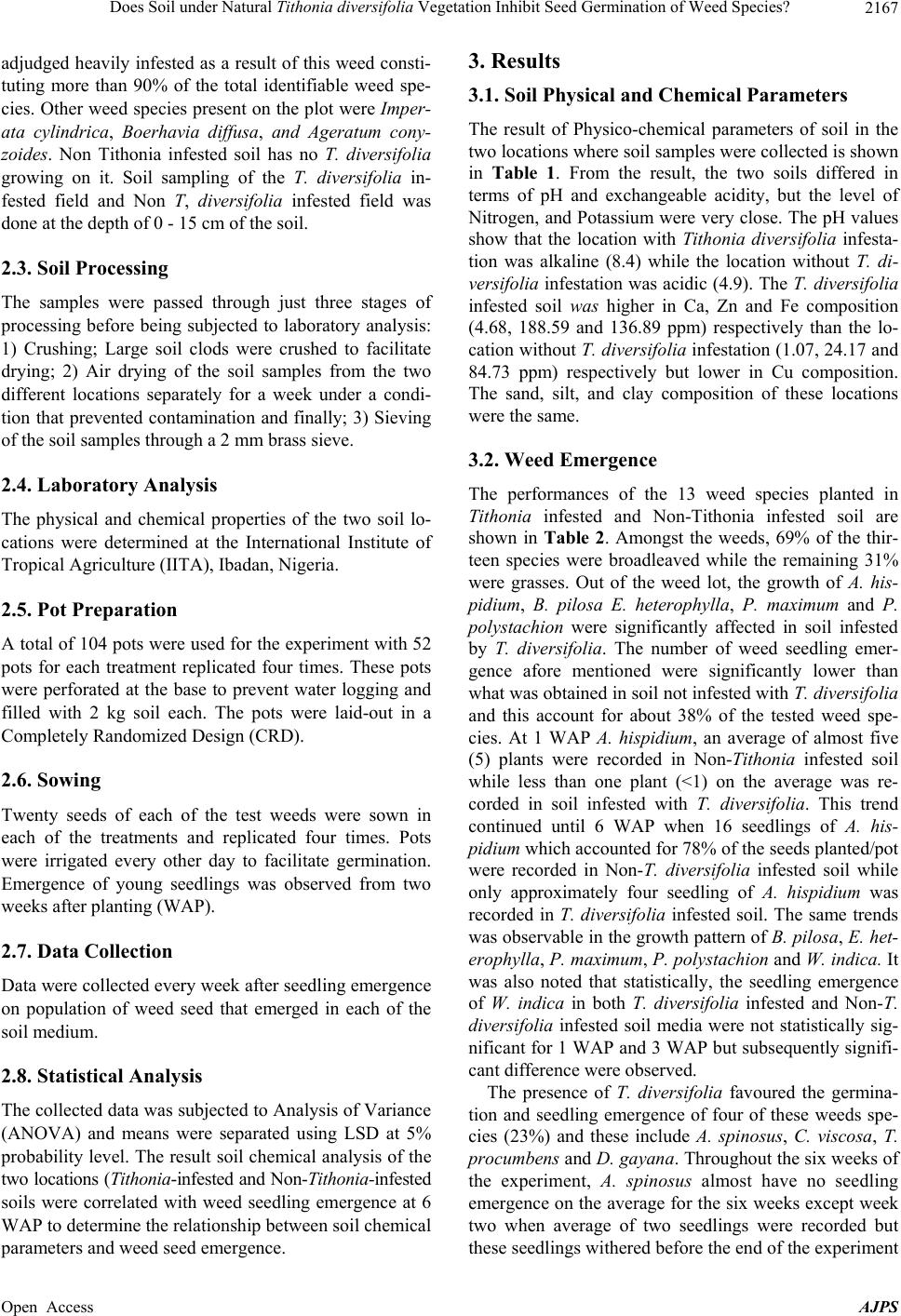 Does Soil under Natural Tithonia diversifolia Vegetation Inhibit Seed Germination of Weed Species? 2167 adjudged heavily infested as a result of this weed consti- tuting more than 90% of the total identifiable weed spe- cies. Other weed species present on the plot were Imper- ata cylindrica, Boerhavia diffusa, and Ageratum cony- zoides. Non Tithonia infested soil has no T. diversifolia growing on it. Soil sampling of the T. diversifolia in- fested field and Non T, diversifolia infested field was done at the depth of 0 - 15 cm of the soil. 2.3. Soil Processing The samples were passed through just three stages of processing before being subjected to laboratory analysis: 1) Crushing; Large soil clods were crushed to facilitate drying; 2) Air drying of the soil samples from the two different locations separately for a week under a condi- tion that prevented contamination and finally; 3) Sieving of the soil samples through a 2 mm brass sieve. 2.4. Laboratory Analysis The physical and chemical properties of the two soil lo- cations were determined at the International Institute of Tropical Agriculture (IITA), Ibadan, Nigeria. 2.5. Pot Preparation A total of 104 pots were used for the experiment with 52 pots for each treatment replicated four times. These pots were perforated at the base to prevent water logging and filled with 2 kg soil each. The pots were laid-out in a Completely Randomized Design (CRD). 2.6. Sowing Twenty seeds of each of the test weeds were sown in each of the treatments and replicated four times. Pots were irrigated every other day to facilitate germination. Emergence of young seedlings was observed from two weeks after planting (WAP). 2.7. Data Collection Data were collected every week after seedling emergence on population of weed seed that emerged in each of the soil medium. 2.8. Statistical Analysis The collected data was subjected to Analysis of Variance (ANOVA) and means were separated using LSD at 5% probability level. The result soil chemical analysis of the two locations (Tithonia-infested and Non-Tithonia-infested soils were correlated with weed seedling emergence at 6 WAP to determine the relationship between soil chemical parameters and weed seed emergence. 3. Results 3.1. Soil Physical and Chemical Parameters The result of Physico-chemical parameters of soil in the two locations where soil samples were collected is shown in Table 1. From the result, the two soils differed in terms of pH and exchangeable acidity, but the level of Nitrogen, and Potassium were very close. The pH values show that the location with Tithonia diversifolia infest a- tion was alkaline (8.4) while the location without T. di- versifolia infestation was acidic (4.9). The T. diversifolia infested soil was higher in Ca, Zn and Fe composition (4.68, 188.59 and 136.89 ppm) respectively than the lo- cation without T. diversifolia infestation (1.07, 24.17 and 84.73 ppm) respectively but lower in Cu composition. The sand, silt, and clay composition of these locations were the same. 3.2. Weed Emergence The performances of the 13 weed species planted in Tithonia infested and Non-Tithonia infested soil are shown in Table 2. Amongst the weeds, 69% of the thir- teen species were broadleaved while the remaining 31% were grasses. Out of the weed lot, the growth of A. his- pidium, B. pilosa E. heterophylla, P. maximum and P. polystachion were significantly affected in soil infested by T. diversifolia. The number of weed seedling emer- gence afore mentioned were significantly lower than what was obtained in soil not infested with T. diversifolia and this account for about 38% of the tested weed spe- cies. At 1 WAP A. hispidium, an average of almost five (5) plants were recorded in Non-Tithonia infested soil while less than one plant (<1) on the average was re- corded in soil infested with T. diversifolia. This trend continued until 6 WAP when 16 seedlings of A. his- pidium which accounted for 78% of the seeds planted/pot were recorded in Non-T. diversifolia infested soil while only approximately four seedling of A. hispidium was recorded in T. diversifolia infested soil. The same trends was observable in the growth pattern of B. pilo sa, E. het- erophylla, P. maximum, P. polystachion and W. indica. It was also noted that statistically, the seedling emergence of W. indica in both T. diversifolia infested and Non-T. diversifolia infested soil media were not statistically sig- nificant for 1 WAP and 3 WAP but subsequently signifi- cant difference were observed. The presence of T. diversifolia favoured the germina- tion and seedling emergence of four of these weeds spe- cies (23%) and these include A. spinosus, C. viscosa, T. procumbens and D. gayana. Throughout the six weeks of the experiment, A. spinosus almost have no seedling emergence on the average for the six weeks except week two when average of two seedlings were recorded but these seedlings withered before the end of the experiment Open Access AJPS 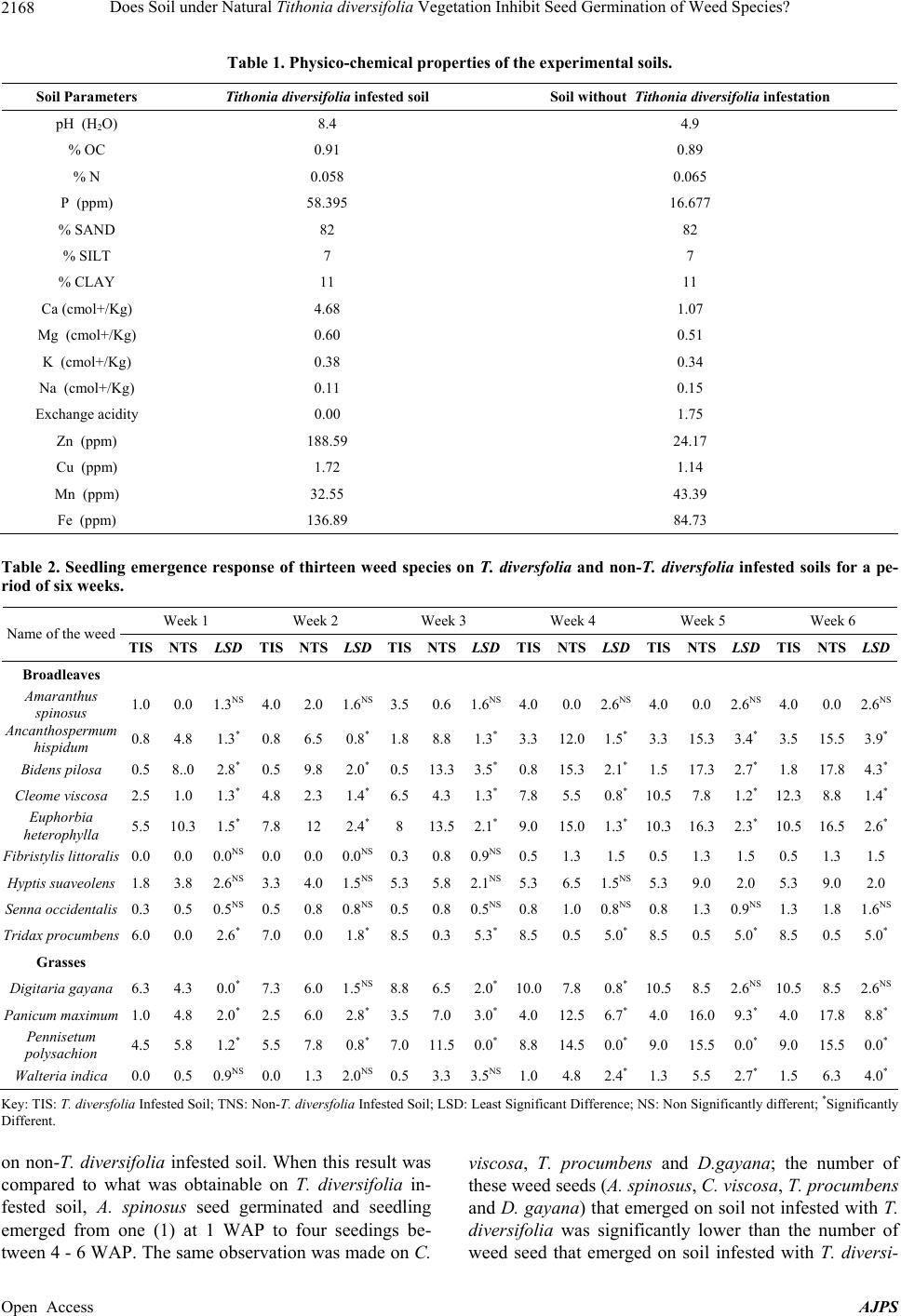 Does Soil under Natural Tithonia diversifolia Vegetation Inhibit Seed Germination of Weed Species? Open Access AJPS 2168 Table 1. Physico-chemical properties of the experimental soils. Soil Parameters Tithonia diversifolia infested soil Soil without Tithonia diversifolia infestation pH (H2O) 8.4 4.9 % OC 0.91 0.89 % N 0.058 0.065 P (ppm) 58.395 16.677 % SAND 82 82 % SILT 7 7 % CLAY 11 11 Ca (cmol+/Kg) 4.68 1.07 Mg (cmol+/Kg) 0.60 0.51 K (cmol+/Kg) 0.38 0.34 Na (cmol+/Kg) 0.11 0.15 Exchange acidity 0.00 1.75 Zn (ppm) 188.59 24.17 Cu (ppm) 1.72 1.14 Mn (ppm) 32.55 43.39 Fe (ppm) 136.89 84.73 Table 2. Seedling emergence response of thirteen weed species on T. diversfolia and non-T. diversfolia infested soils for a pe- riod of six weeks. Week 1 Week 2 Week 3 Week 4 Week 5 Week 6 Name of the weed TIS NTS LSD TIS NTS LSD TIS NTSLSD TISNTS LSD TISNTS LSD TIS NTSLSD Broadleaves Amaranthus spinosus 1.0 0.0 1.3NS 4.0 2.0 1.6NS 3.50.6 1.6NS 4.00.0 2.6NS 4.00.0 2.6NS 4.0 0.02.6NS Ancanthospermum hispidum 0.8 4.8 1.3* 0.8 6.5 0.8*1.8 8.8 1.3*3.312.0 1.5*3.315.3 3.4* 3.5 15.53.9* Bidens pilosa 0.5 8..0 2.8* 0.5 9.8 2.0*0.5 13.3 3.5*0.815.3 2.1*1.517.3 2.7* 1.8 17.84.3* Cleome viscosa 2.5 1.0 1.3* 4.8 2.3 1.4*6.5 4.31.3*7.85.5 0.8*10.57.8 1.2* 12.3 8.81.4* Euphorbia heterophylla 5.5 10.3 1.5* 7.8 12 2.4*8 13.52.1*9.015.0 1.3*10.316.3 2.3* 10.5 16.52.6* Fibristylis littoralis 0.0 0.0 0.0NS 0.0 0.0 0.0NS 0.30.8 0.9NS 0.51.3 1.50.51.3 1.5 0.5 1.3 1.5 Hyptis suaveolens 1.8 3.8 2.6NS 3.3 4.0 1.5NS 5.35.8 2.1NS 5.36.5 1.5NS 5.39.0 2.0 5.3 9.0 2.0 Senna occidentalis 0.3 0.5 0.5NS 0.5 0.8 0.8NS 0.50.8 0.5NS 0.81.0 0.8NS 0.81.3 0.9NS 1.3 1.81.6NS Tridax procumbens 6.0 0.0 2.6* 7.0 0.0 1.8*8.5 0.35.3*8.5 0.5 5.0*8.50.5 5.0* 8.5 0.55.0* Grasses Digitaria gayana 6.3 4.3 0.0* 7.3 6.0 1.5NS 8.8 6.52.0*10.0 7.80.8*10.58.5 2.6NS 10.5 8.52.6NS Panicum maximum 1.0 4.8 2.0* 2.5 6.0 2.8*3.5 7.03.0*4.012.56.7*4.016.0 9.3* 4.0 17.88.8* Pennisetum polysachion 4.5 5.8 1.2* 5.5 7.8 0.8*7.0 11.5 0.0*8.814.5 0.0*9.015.5 0.0* 9.0 15.50.0* Walteria indica 0.0 0.5 0.9NS 0.0 1.3 2.0NS 0.53.3 3.5NS1.04.8 2.4*1.35.5 2.7* 1.5 6.34.0* Key: TIS: T. diversfolia Infested Soil; TNS: Non-T. diversfolia Infested Soil; LSD: Least Significant Difference; NS: Non Significantly different; *Significantly Different. on non-T. diversifolia infested soil. When this result was compared to what was obtainable on T. diversifolia in- fested soil, A. spinosus seed germinated and seedling emerged from one (1) at 1 WAP to four seedings be- tween 4 - 6 WAP. The same observation was made on C. viscosa, T. procumbens and D.gayana ; the number of these weed seeds (A. spin osus, C. viscosa, T. procumbens and D. gayana) that emerged on soil not infested with T. diversifolia was significantly lower than the number of weed seed that emerged on soil infested with T. diversi- 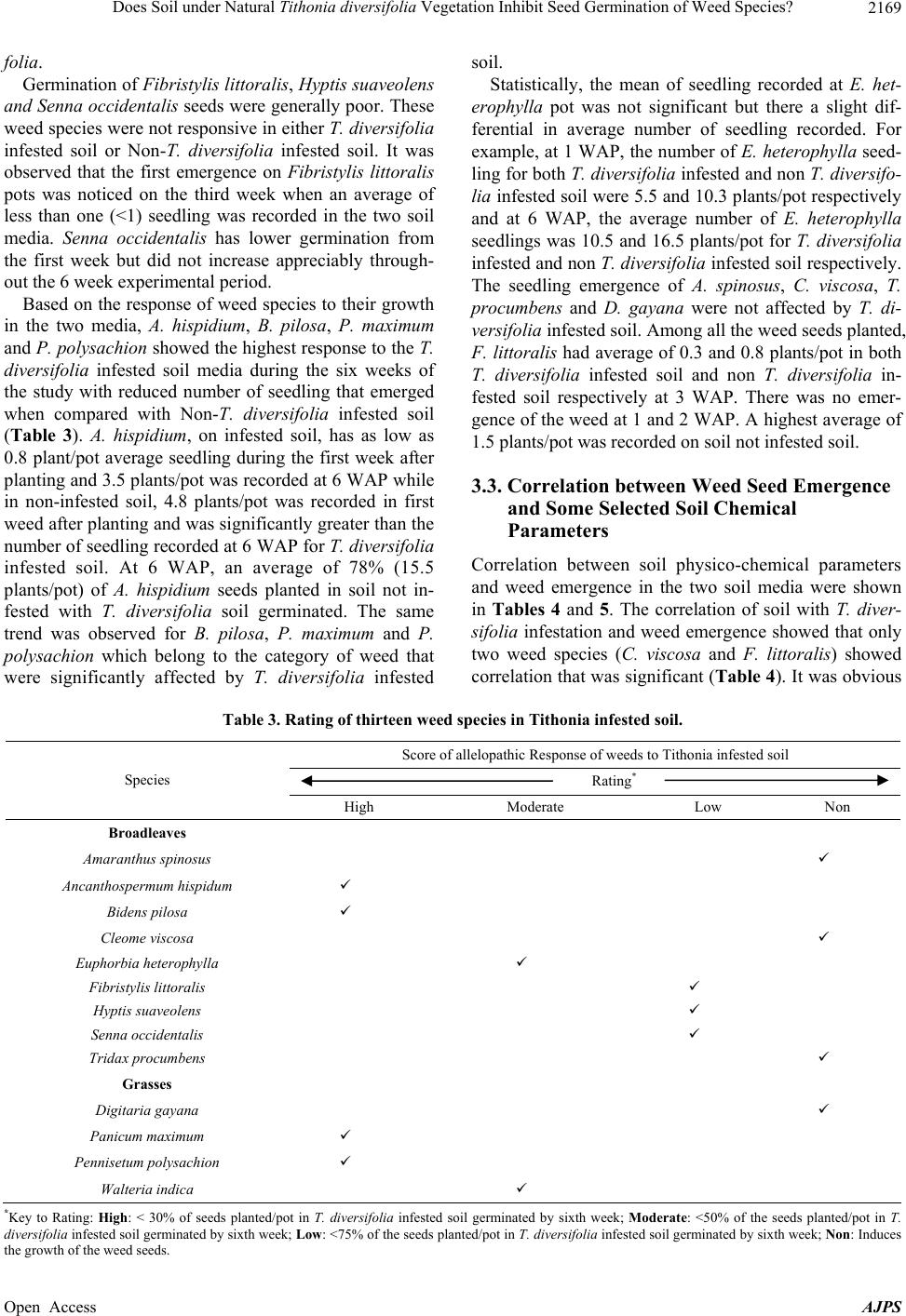 Does Soil under Natural Tithonia diversifolia Vegetation Inhibit Seed Germination of Weed Species? 2169 folia. Germination of Fibristylis littoralis, Hyptis suaveolen s and Senna occidentalis seeds were generally poor. These weed species were not responsive in either T. diversifolia infested soil or Non-T. diversifolia infested soil. It was observed that the first emergence on Fibristylis littoralis pots was noticed on the third week when an average of less than one (<1) seedling was recorded in the two soil media. Senna occidentalis has lower germination from the first week but did not increase appreciably through- out the 6 week experimental period. Based on the response of weed species to their growth in the two media, A. hispidium, B. pilosa, P. maximum and P. polysa chion showed the highest response to the T. diversifolia infested soil media during the six weeks of the study with reduced number of seedling that emerged when compared with Non-T. diversifolia infested soil (Table 3). A. hispidium, on infested soil, has as low as 0.8 plant/pot average seedling during the first week after planting and 3.5 plants/pot was recorded at 6 WAP while in non-infested soil, 4.8 plants/pot was recorded in first weed after planting and was significantly greater than the number of seedling recorded at 6 WAP for T. diversifolia infested soil. At 6 WAP, an average of 78% (15.5 plants/pot) of A. hispidium seeds planted in soil not in- fested with T. diversifolia soil germinated. The same trend was observed for B. pilosa, P. maximum and P. polysachion which belong to the category of weed that were significantly affected by T. diversifolia infested soil. Statistically, the mean of seedling recorded at E. het- erophylla pot was not significant but there a slight dif- ferential in average number of seedling recorded. For example, at 1 WAP, the number of E. heterophylla seed- ling for both T. diversifo lia infested and non T. diversifo- lia infested soil were 5.5 and 10.3 plants/pot respectively and at 6 WAP, the average number of E. heterophylla seedlings was 10.5 and 16.5 plants/pot for T. diversifolia infested and non T. diversifolia infested soil respectively. The seedling emergence of A. spinosus, C. viscosa, T. procumbens and D. gayana were not affected by T. di- versifolia infested soil. Among all the weed seeds planted, F. littoralis had average of 0.3 and 0.8 plants/pot in both T. diversifolia infested soil and non T. diversifolia in- fested soil respectively at 3 WAP. There was no emer- gence of the weed at 1 and 2 WAP. A highest average of 1.5 plants/pot was recorded on soil not infested soil. 3.3. Correlation between Weed Seed Emergence and Some Selected Soil Chemical Parameters Correlation between soil physico-chemical parameters and weed emergence in the two soil media were shown in Tables 4 and 5. The correlation of soil with T. diver- sifolia infestation and weed emergence showed that only two weed species (C. viscosa and F. littoralis) showed correlation that was significant (Table 4). It was obvious Table 3. Rating of thirteen weed species in Tithonia infested soil. Score of allelopathic Response o weeds to Tithonia infested soil f Rating * Species High Moderate Low Non Broadleaves Amaranthus spinosus Ancanthospermum hispidum Bidens pilosa Cleome viscosa Euphorbia heterophylla Fibristylis littoralis Hyptis suaveolens Senna occidentalis Tridax procumbens Grasses Digitaria gayana Panicum maximum Pennisetum polysachion Walteria indica *Key to Rating: High: < 30% of seeds planted/pot in T. diversifolia infested soil germinated by sixth week; Moderate: <50% of the seeds planted/pot in T. diversifolia infested soil germinated by sixth week; Low: <75% of the seeds planted/pot in T. diversifolia infested soil germinated by sixth week; Non: Induces the growth of the weed seeds. Open Access AJPS 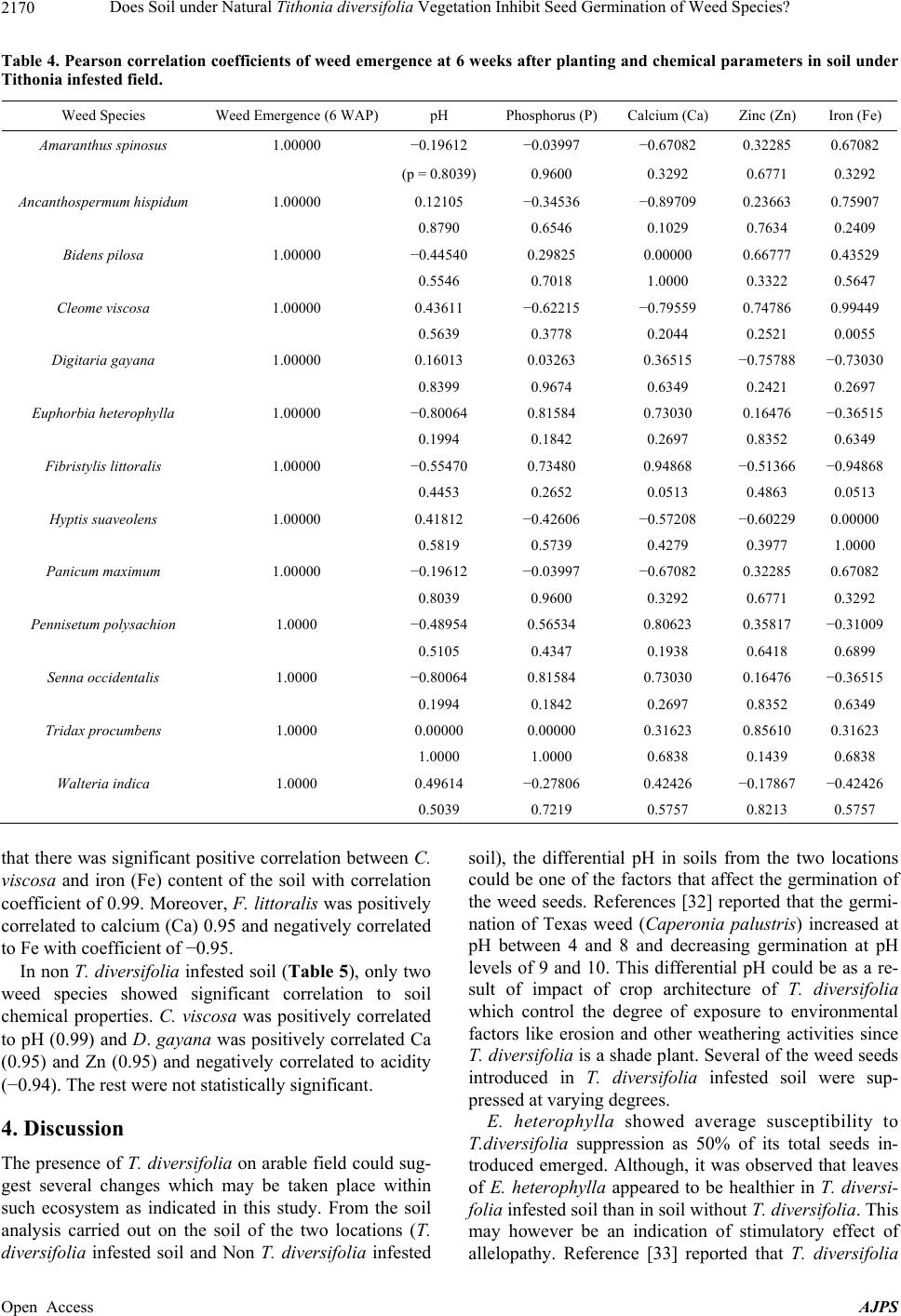 Does Soil under Natural Tithonia diversifolia Vegetation Inhibit Seed Germination of Weed Species? 2170 Table 4. Pearson correlation c oefficients of weed emergence at 6 weeks after planting and che mical parameters in soil under Tithonia infested field. Weed Species Weed Emergence (6 WAP)pH Phosphorus (P) Calcium (Ca) Zinc (Zn) Iron (Fe) Amaranthus spinosus 1.00000 −0.19612 −0.03997 −0.67082 0.32285 0.67082 (p = 0.8039)0.9600 0.3292 0.6771 0.3292 Ancanthospermum hispidum 1.00000 0.12105 −0.34536 −0.89709 0.23663 0.75907 0.8790 0.6546 0.1029 0.7634 0.2409 Bidens pilosa 1.00000 −0.44540 0.29825 0.00000 0.66777 0.43529 0.5546 0.7018 1.0000 0.3322 0.5647 Cleome viscosa 1.00000 0.43611 −0.62215 −0.79559 0.74786 0.99449 0.5639 0.3778 0.2044 0.2521 0.0055 Digitaria gayana 1.00000 0.16013 0.03263 0.36515 −0.75788 −0.73030 0.8399 0.9674 0.6349 0.2421 0.2697 Euphorbia heterophylla 1.00000 −0.80064 0.81584 0.73030 0.16476 −0.36515 0.1994 0.1842 0.2697 0.8352 0.6349 Fibristylis littoralis 1.00000 −0.55470 0.73480 0.94868 −0.51366 −0.94868 0.4453 0.2652 0.0513 0.4863 0.0513 Hyptis suaveolens 1.00000 0.41812 −0.42606 −0.57208 −0.60229 0.00000 0.5819 0.5739 0.4279 0.3977 1.0000 Panicum maximum 1.00000 −0.19612 −0.03997 −0.67082 0.32285 0.67082 0.8039 0.9600 0.3292 0.6771 0.3292 Pennisetum polysachion 1.0000 −0.48954 0.56534 0.80623 0.35817 −0.31009 0.5105 0.4347 0.1938 0.6418 0.6899 Senna occidentalis 1.0000 −0.80064 0.81584 0.73030 0.16476 −0.36515 0.1994 0.1842 0.2697 0.8352 0.6349 Tridax procumbens 1.0000 0.00000 0.00000 0.31623 0.85610 0.31623 1.0000 1.0000 0.6838 0.1439 0.6838 Walteria indica 1.0000 0.49614 −0.27806 0.42426 −0.17867 −0.42426 0.5039 0.7219 0.5757 0.8213 0.5757 that there was significant positive correlation between C. viscosa and iron (Fe) content of the soil with correlation coefficient of 0.99. Moreover, F. littoralis was positively correlated to calcium (Ca) 0.95 and negatively correlated to Fe with coefficient of −0.95. In non T. diversifolia infested soil (Table 5 ), only two weed species showed significant correlation to soil chemical properties. C. viscosa was positively correlated to pH (0.99) and D. gayana was positively correlated Ca (0.95) and Zn (0.95) and negatively correlated to acidity (−0.94). The rest were not statistically significant. 4. Discussion The presence of T. diversifolia on arable field could sug- gest several changes which may be taken place within such ecosystem as indicated in this study. From the soil analysis carried out on the soil of the two locations (T. diversifolia infested soil and Non T. diversifolia infested soil), the differential pH in soils from the two locations could be one of the factors that affect the germination of the weed seeds. References [32] reported that the germi- nation of Texas weed (Caperonia palustris) increased at pH between 4 and 8 and decreasing germination at pH levels of 9 and 10. This differential pH could be as a re- sult of impact of crop architecture of T. diversifolia which control the degree of exposure to environmental factors like erosion and other weathering activities since T. diversifolia is a shade plant. Several of the weed seeds introduced in T. diversifolia infested soil were sup- pressed at varying degrees. E. heterophylla showed average susceptibility to T.diversifolia suppression as 50% of its total seeds in- troduced emerged. Although, it was observed that leaves of E. heterophylla appeared to be healthier in T. diversi- folia infested soil than in soil without T. diversifolia. This may however be an indication of stimulatory effect of allelopathy. Reference [33] reported that T. diversifolia Open Access AJPS 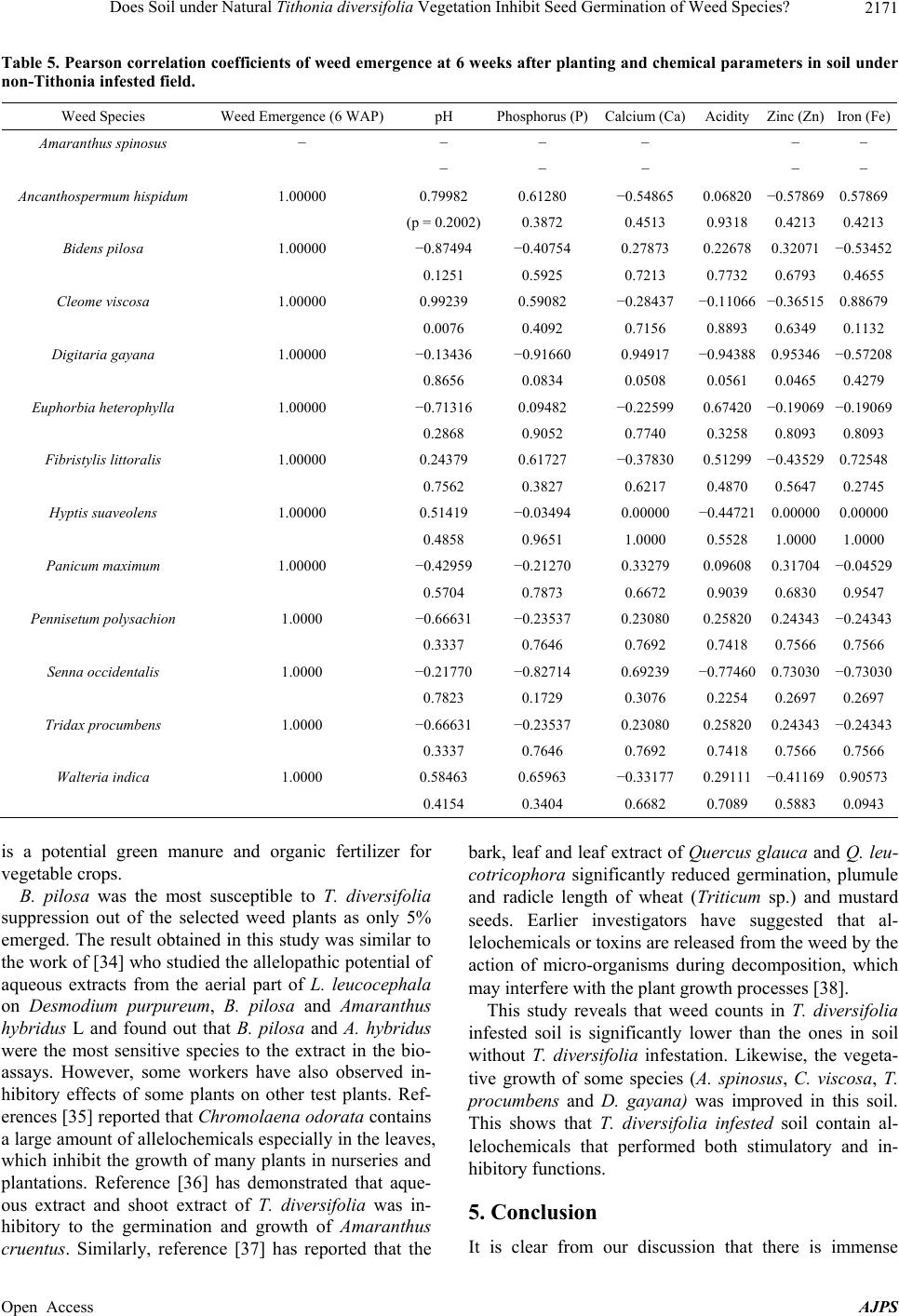 Does Soil under Natural Tithonia diversifolia Vegetation Inhibit Seed Germination of Weed Species? 2171 Table 5. Pearson correlation c oefficients of weed emergence at 6 weeks after planting and chem ical parameters in soil under non-Tithonia infested field. Weed Species Weed Emergence (6 WAP) pH Phosphorus (P)Calcium (Ca) Acidity Zinc (Zn)Iron (Fe) Amaranthus spinosus − − − − − − − − − − − Ancanthospermum hispidum 1.00000 0.79982 0.61280 −0.54865 0.06820 −0.57869 0.57869 (p = 0.2002)0.3872 0.4513 0.9318 0.42130.4213 Bidens pilosa 1.00000 −0.87494 −0.40754 0.27873 0.22678 0.32071−0.53452 0.1251 0.5925 0.7213 0.7732 0.67930.4655 Cleome viscosa 1.00000 0.99239 0.59082 −0.28437 −0.11066 −0.36515 0.88679 0.0076 0.4092 0.7156 0.8893 0.63490.1132 Digitaria gayana 1.00000 −0.13436 −0.91660 0.94917 −0.94388 0.95346−0.57208 0.8656 0.0834 0.0508 0.0561 0.04650.4279 Euphorbia heterophylla 1.00000 −0.71316 0.09482 −0.22599 0.67420 −0.19069 −0.19069 0.2868 0.9052 0.7740 0.3258 0.80930.8093 Fibristylis littoralis 1.00000 0.24379 0.61727 −0.37830 0.51299 −0.43529 0.72548 0.7562 0.3827 0.6217 0.4870 0.56470.2745 Hyptis suaveolens 1.00000 0.51419 −0.03494 0.00000 −0.44721 0.000000.00000 0.4858 0.9651 1.0000 0.5528 1.00001.0000 Panicum maximum 1.00000 −0.42959 −0.21270 0.33279 0.09608 0.31704−0.04529 0.5704 0.7873 0.6672 0.9039 0.6830 0.9547 Pennisetum polysachion 1.0000 −0.66631 −0.23537 0.23080 0.25820 0.24343−0.24343 0.3337 0.7646 0.7692 0.7418 0.75660.7566 Senna occidentalis 1.0000 −0.21770 −0.82714 0.69239 −0.77460 0.73030−0.73030 0.7823 0.1729 0.3076 0.2254 0.26970.2697 Tridax procumbens 1.0000 −0.66631 −0.23537 0.23080 0.25820 0.24343−0.24343 0.3337 0.7646 0.7692 0.7418 0.75660.7566 Walteria indica 1.0000 0.58463 0.65963 −0.33177 0.29111 −0.41169 0.90573 0.4154 0.3404 0.6682 0.7089 0.58830.0943 is a potential green manure and organic fertilizer for vegetable crops. B. pilosa was the most susceptible to T. diversifolia suppression out of the selected weed plants as only 5% emerged. The result obtained in this study was similar to the work of [34] who studied the allelopathic potential of aqueous extracts from the aerial part of L. leucocephala on Desmodium purpureum, B. pilosa and Amaranthus hybridus L and found out that B. pilosa and A. hybridus were the most sensitive species to the extract in the bio- assays. However, some workers have also observed in- hibitory effects of some plants on other test plants. Ref- erences [35] reported that Chromolaen a odorata contains a large amount of allelochemicals especially in the leaves, which inhibit the growth of many plants in nurseries and plantations. Reference [36] has demonstrated that aque- ous extract and shoot extract of T. diversifolia was in- hibitory to the germination and growth of Amaranthus cruentus. Similarly, reference [37] has reported that the bark, leaf and leaf extract of Quercus glauca and Q. leu- cotricophora significantly reduced germination, plumule and radicle length of wheat (Triticum sp.) and mustard seeds. Earlier investigators have suggested that al- lelochemicals or toxins are released from the weed by the action of micro-organisms during decomposition, which may interfere with the plant growth processes [38]. This study reveals that weed counts in T. diversifolia infested soil is significantly lower than the ones in soil without T. diversifolia infestation. Likewise, the vegeta- tive growth of some species (A. spinosus, C. viscosa, T. procumbens and D. gayana) was improved in this soil. This shows that T. diversifolia infested soil contain al- lelochemicals that performed both stimulatory and in- hibitory functions. 5. Conclusion It is clear from our discussion that there is immense Open Access AJPS 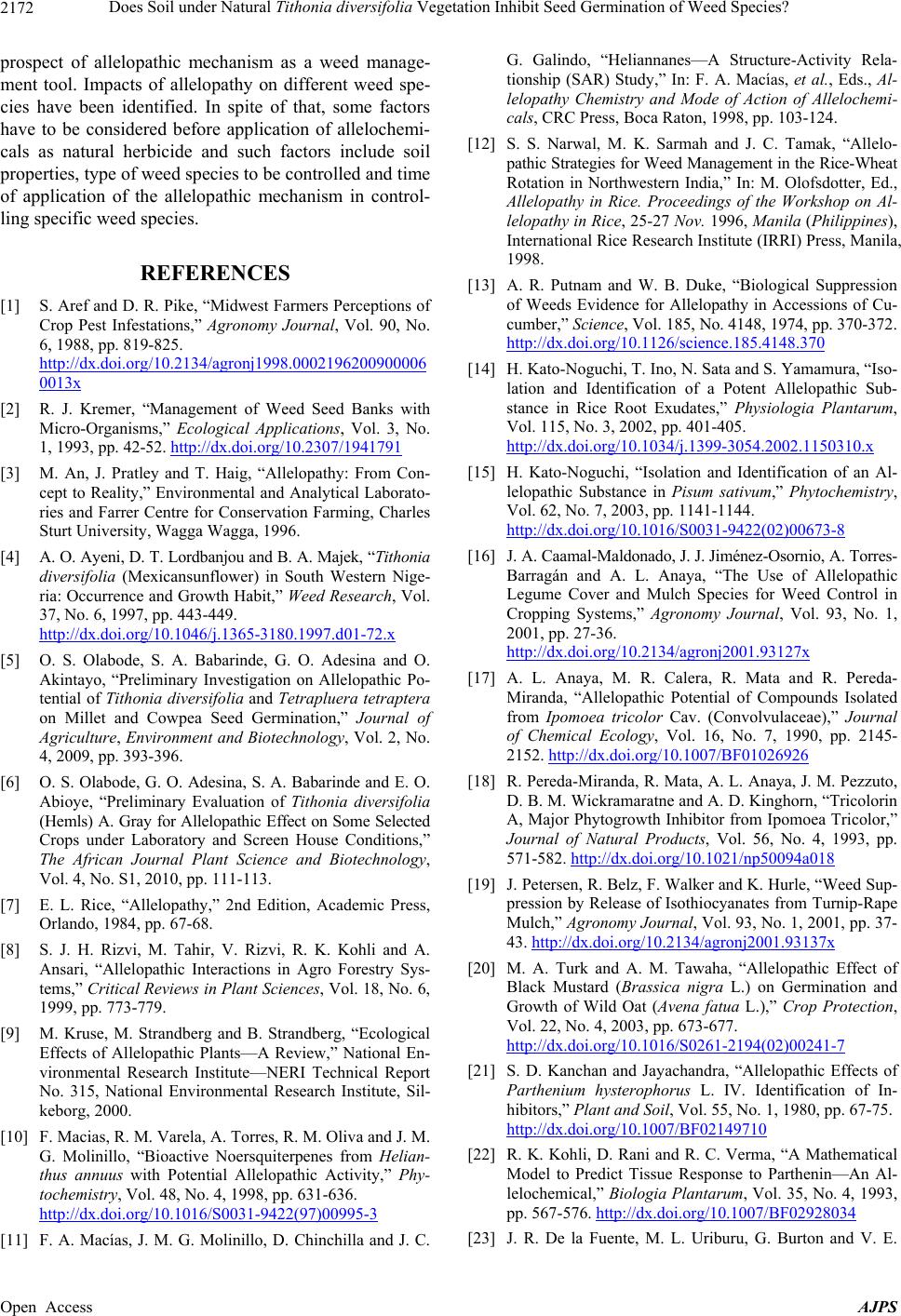 Does Soil under Natural Tithonia diversifolia Vegetation Inhibit Seed Germination of Weed Species? 2172 prospect of allelopathic mechanism as a weed manage- ment tool. Impacts of allelopathy on different weed spe- cies have been identified. In spite of that, some factors have to be considered before application of allelochemi- cals as natural herbicide and such factors include soil properties, type of weed species to be controlled and time of application of the allelopathic mechanism in control- ling specific weed species. REFERENCES [1] S. Aref and D. R. Pike, “Midwest Farmers Perceptions of Crop Pest Infestations,” Agronomy Journal, Vol. 90, No. 6, 1988, pp. 819-825. http://dx.doi.org/10.2134/agronj1998.0002196200900006 0013x [2] R. J. Kremer, “Management of Weed Seed Banks with Micro-Organisms,” Ecological Applications, Vol. 3, No. 1, 1993, pp. 42-52. http://dx.doi.org/10.2307/1941791 [3] M. An, J. Pratley and T. Haig, “Allelopathy: From Con- cept to Reality,” Environmental and Analytical Laborato- ries and Farrer Centre for Conservation Farming, Charles Sturt University, Wagga Wagga, 1996. [4] A. O. Ayeni, D. T. Lordbanjou and B. A. Majek, “Tithonia diversifolia (Mexicansunflower) in South Western Nige- ria: Occurrence and Growth Habit,” Weed Research, Vol. 37, No. 6, 1997, pp. 443-449. http://dx.doi.org/10.1046/j.1365-3180.1997.d01-72.x [5] O. S. Olabode, S. A. Babarinde, G. O. Adesina and O. Akintayo, “Preliminary Investigation on Allelopathic Po- tential of Tithonia diversifolia and Tetrapluera tetraptera on Millet and Cowpea Seed Germination,” Journal of Agriculture, Environment and Biotechnology, Vol. 2, No. 4, 2009, pp. 393-396. [6] O. S. Olabode, G. O. Adesina, S. A. Babarinde and E. O. Abioye, “Preliminary Evaluation of Tithonia diversifolia (Hemls) A. Gray for Allelopathic Effect on Some Selected Crops under Laboratory and Screen House Conditions,” The African Journal Plant Science and Biotechnology, Vol. 4, No. S1, 2010, pp. 111-113. [7] E. L. Rice, “Allelopathy,” 2nd Edition, Academic Press, Orlando, 1984, pp. 67-68. [8] S. J. H. Rizvi, M. Tahir, V. Rizvi, R. K. Kohli and A. Ansari, “Allelopathic Interactions in Agro Forestry Sys- tems,” Critical Reviews in Plant Sciences, Vol. 18, No. 6, 1999, pp. 773-779. [9] M. Kruse, M. Strandberg and B. Strandberg, “Ecological Effects of Allelopathic Plants—A Review,” National En- vironmental Research Institute—NERI Technical Report No. 315, National Environmental Research Institute, Sil- keborg, 2000. [10] F. Macias, R. M. Varela, A. Torres, R. M. Oliva and J. M. G. Molinillo, “Bioactive Noersquiterpenes from Helian- thus annuus with Potential Allelopathic Activity,” Phy- tochemistry, Vol. 48, No. 4, 1998, pp. 631-636. http://dx.doi.org/10.1016/S0031-9422(97)00995-3 [11] F. A. Macías, J. M. G. Molinillo, D. Chinchilla and J. C. G. Galindo, “Heliannanes—A Structure-Activity Rela- tionship (SAR) Study,” In: F. A. Macías, et al., Eds., Al- lelopathy Chemistry and Mode of Action of Allelochemi- cals, CRC Press, Boca Raton, 1998, pp. 103-124. [12] S. S. Narwal, M. K. Sarmah and J. C. Tamak, “Allelo- pathic Strategies for Weed Management in the Rice-Wheat Rotation in Northwestern India,” In: M. Olofsdotter, Ed., Allelopathy in Rice. Proceedings of the Workshop on Al- lelopathy in Rice, 25-27 Nov. 1996, Manila (Philippines), International Rice Research Institute (IRRI) Press, Manila, 1998. [13] A. R. Putnam and W. B. Duke, “Biological Suppression of Weeds Evidence for Allelopathy in Accessions of Cu- cumber,” Science, Vol. 185, No. 4148, 1974, pp. 370-372. http://dx.doi.org/10.1126/science.185.4148.370 [14] H. Kato-Noguchi, T. Ino, N. Sata and S. Yamamura, “Iso- lation and Identification of a Potent Allelopathic Sub- stance in Rice Root Exudates,” Physiologia Plantarum, Vol. 115, No. 3, 2002, pp. 401-405. http://dx.doi.org/10.1034/j.1399-3054.2002.1150310.x [15] H. Kato-Noguchi, “Isolation and Identification of an Al- lelopathic Substance in Pisum sativum,” Phytochemistry, Vol. 62, No. 7, 2003, pp. 1141-1144. http://dx.doi.org/10.1016/S0031-9422(02)00673-8 [16] J. A. Caamal-Maldonado, J. J. Jiménez-Osornio, A. Torres- Barragán and A. L. Anaya, “The Use of Allelopathic Legume Cover and Mulch Species for Weed Control in Cropping Systems,” Agronomy Journal, Vol. 93, No. 1, 2001, pp. 27-36. http://dx.doi.org/10.2134/agronj2001.93127x [17] A. L. Anaya, M. R. Calera, R. Mata and R. Pereda- Miranda, “Allelopathic Potential of Compounds Isolated from Ipomoea tricolor Cav. (Convolvulaceae),” Journal of Chemical Ecology, Vol. 16, No. 7, 1990, pp. 2145- 2152. http://dx.doi.org/10.1007/BF01026926 [18] R. Pereda-Miranda, R. Mata, A. L. Anaya, J. M. Pezzuto, D. B. M. Wickramaratne and A. D. Kinghorn, “Tricolorin A, Major Phytogrowth Inhibitor from Ipomoea Tricolor,” Journal of Natural Products, Vol. 56, No. 4, 1993, pp. 571-582. http://dx.doi.org/10.1021/np50094a018 [19] J. Petersen, R. Belz, F. Walker and K. Hurle, “Weed Sup- pression by Release of Isothiocyanates from Turnip-Rape Mulch,” Agronomy Journal, Vol. 93, No. 1, 2001, pp. 37- 43. http://dx.doi.org/10.2134/agronj2001.93137x [20] M. A. Turk and A. M. Tawaha, “Allelopathic Effect of Black Mustard (Brassica nigra L.) on Germination and Growth of Wild Oat (Avena fatua L.),” Crop Protection, Vol. 22, No. 4, 2003, pp. 673-677. http://dx.doi.org/10.1016/S0261-2194(02)00241-7 [21] S. D. Kanchan and Jayachandra, “Allelopathic Effects of Parthenium hysterophorus L. IV. Identification of In- hibitors,” Plant and Soil, Vol. 55, No. 1, 1980, pp. 67-75. http://dx.doi.org/10.1007/BF02149710 [22] R. K. Kohli, D. Rani and R. C. Verma, “A Mathematical Model to Predict Tissue Response to Parthenin—An Al- lelochemical,” Biologia Plantarum, Vol. 35, No. 4, 1993, pp. 567-576. http://dx.doi.org/10.1007/BF02928034 [23] J. R. De la Fuente, M. L. Uriburu, G. Burton and V. E. Open Access AJPS 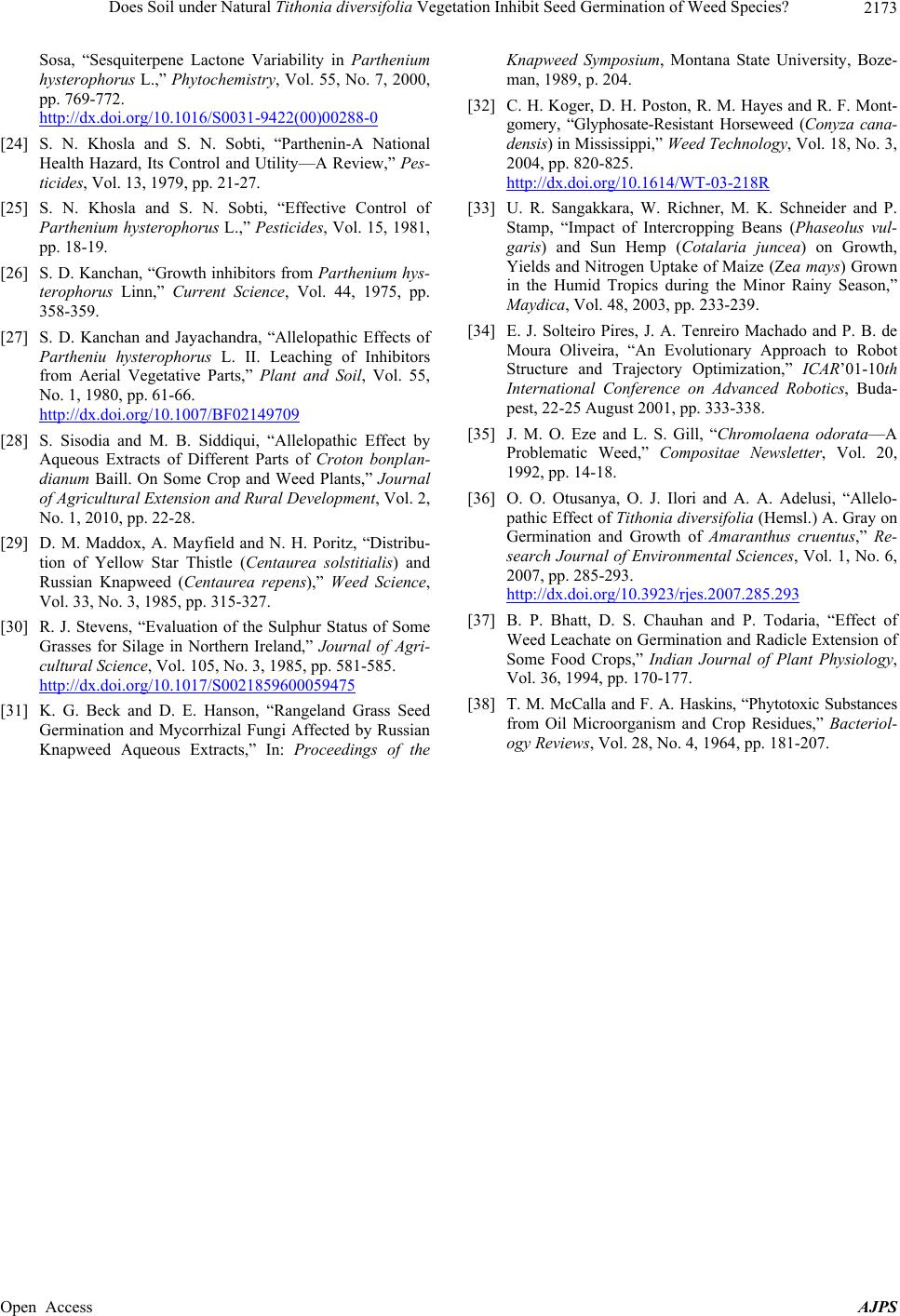 Does Soil under Natural Tithonia diversifolia Vegetation Inhibit Seed Germination of Weed Species? Open Access AJPS 2173 Sosa, “Sesquiterpene Lactone Variability in Parthenium hysterophorus L.,” Phytochemistry , Vol. 55, No. 7, 2000, pp. 769-772. http://dx.doi.org/10.1016/S0031-9422(00)00288-0 [24] S. N. Khosla and S. N. Sobti, “Parthenin-A National Health Hazard, Its Control and Utility—A Review,” Pes- ticides, Vol. 13, 1979, pp. 21-27. [25] S. N. Khosla and S. N. Sobti, “Effective Control of Parthenium hysterophorus L.,” Pesticides, Vol. 15, 1981, pp. 18-19. [26] S. D. Kanchan, “Growth inhibitors from Parthenium hys- terophorus Linn,” Current Science, Vol. 44, 1975, pp. 358-359. [27] S. D. Kanchan and Jayachandra, “Allelopathic Effects of Partheniu hysterophorus L. II. Leaching of Inhibitors from Aerial Vegetative Parts,” Plant and Soil, Vol. 55, No. 1, 1980, pp. 61-66. http://dx.doi.org/10.1007/BF02149709 [28] S. Sisodia and M. B. Siddiqui, “Allelopathic Effect by Aqueous Extracts of Different Parts of Croton bonplan- dianum Baill. On Some Crop and Weed Plants,” Journal of Agricultural Extension and Rural Development, Vol. 2, No. 1, 2010, pp. 22-28. [29] D. M. Maddox, A. Mayfield and N. H. Poritz, “Distribu- tion of Yellow Star Thistle (Centaurea solstitialis) and Russian Knapweed (Centaurea repens),” Weed Science, Vol. 33, No. 3, 1985, pp. 315-327. [30] R. J. Stevens, “Evaluation of the Sulphur Status of Some Grasses for Silage in Northern Ireland,” Journal of Agri- cultural Science, Vol. 105, No. 3, 1985, pp. 581-585. http://dx.doi.org/10.1017/S0021859600059475 [31] K. G. Beck and D. E. Hanson, “Rangeland Grass Seed Germination and Mycorrhizal Fungi Affected by Russian Knapweed Aqueous Extracts,” In: Proceedings of the Knapweed Symposium, Montana State University, Boze- man, 1989, p. 204. [32] C. H. Koger, D. H. Poston, R. M. Hayes and R. F. Mont- gomery, “Glyphosate-Resistant Horseweed (Conyza cana- densis) in Mississippi,” Weed Technology, Vol. 18, No. 3, 2004, pp. 820-825. http://dx.doi.org/10.1614/WT-03-218R [33] U. R. Sangakkara, W. Richner, M. K. Schneider and P. Stamp, “Impact of Intercropping Beans (Phaseolus vul- garis) and Sun Hemp (Cotalaria juncea) on Growth, Yields and Nitrogen Uptake of Maize (Zea mays) Grown in the Humid Tropics during the Minor Rainy Season,” Maydica, Vol. 48, 2003, pp. 233-239. [34] E. J. Solteiro Pires, J. A. Tenreiro Machado and P. B. de Moura Oliveira, “An Evolutionary Approach to Robot Structure and Trajectory Optimization,” ICAR’01-10th International Conference on Advanced Robotics, Buda- pest, 22-25 August 2001, pp. 333-338. [35] J. M. O. Eze and L. S. Gill, “Chromolaena odorata—A Problematic Weed,” Compositae Newsletter, Vol. 20, 1992, pp. 14-18. [36] O. O. Otusanya, O. J. Ilori and A. A. Adelusi, “Allelo- pathic Effect of Tithonia diversifolia (Hemsl.) A. Gray on Germination and Growth of Amaranthus cruentus,” Re- search Journal of Environmental Sciences, Vol. 1, No. 6, 2007, pp. 285-293. http://dx.doi.org/10.3923/rjes.2007.285.293 [37] B. P. Bhatt, D. S. Chauhan and P. Todaria, “Effect of Weed Leachate on Germination and Radicle Extension of Some Food Crops,” Indian Journal of Plant Physiology, Vol. 36, 1994, pp. 170-177. [38] T. M. McCalla and F. A. Haskins, “Phytotoxic Substances from Oil Microorganism and Crop Residues,” Bacteriol- ogy Reviews, Vol. 28, No. 4, 1964, pp. 181-207.
|